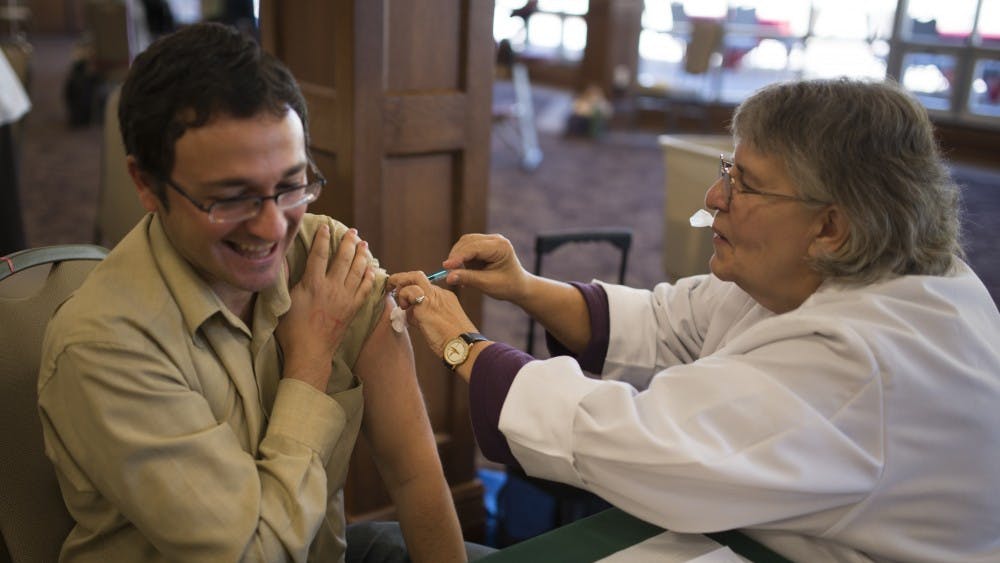Quick-fix multi-vitamin supplements have become a growing health trend among Americans. As the health-concious so nciety is growing, so are vitamin sales. Consumers scarf down $7 billion worth of vitamins, according to the Wall Street Journal. Seventy percent of Americans pay homage to the health store gods and swear by their vitamin routines. As vitamins become more popular, it is important for users to get all the facts to make smart choices. \n"Some people are just religious about their supplements," said Stacey Matavuli, a registered dietician at Bloomington Hospital and an outreach educator for IU Health and Wellness. \nFor some people, vitamins are self-prescribed placebos, while for others, vitamins are a supplement safety net. And of course, there is the slice of Americans who use vitamins as an excuse for a slice of cake, using vitamins to supplement healthy eating. This trend shows Americans aren't buying the "less is more" aphorism anymore; they are buying vitamins, and lots of them," Matavuli said. \n"There has been an increased interest (in vitamins)," said Victoria Bigelow, manager of the department of Wellness at Bloomingfoods co-op grocery store. \nMuch of consumer health decisions reflect what is available in stores or what is in the media, Bigelow said. It depends on "what they've seen on Oprah," she said with a laugh.\nConsumers are bombarded with billboards, commercials and neighborly gossip every day. Because finding the right source for health advice can be confusing, turning to nutrition supplements åVitamins have not always been a common household item. According to the U.S. Centers for Diseases Control and Prevention, a discovery in 1916 suggested the "lack of 'vital amines' could cause disease." As a result of increased awareness of the importance of certain nutrients, there was a significant reduction of disease during the first half of the century. Since then, according to the CDC, attention to health care and lifestyle received greater attention from average consumers and health care officials. \nMatavuli follows a "food-first" philosophy. She said she believes if the body is getting a balanced diet, eating at \nconsistent times every day and snacking only when \nnecessary, then there is less need for a multi-vitamin. But in college, when a balanced diet can be more of a challenge, the multi-vitamin is "just an added insurance," she said. Though eating right in college can be tough, Matavuli said many students do come to ask if they are making the right food choices. College is a time when students are "out on their own and have more control over what they purchase," Matavuli said. This independent time is when college students often start taking vitamins, she said. How people value their vitamins is often a reflection of parents' values.\n"In high school, my mom put me on women's multivitamins," said sophomore Anna Rivera, a self-proclaimed "health-nut," who's been taking vitamins since about age 10. Rivera said her mother has "always taken them and they make her feel better, and obviously they're good for you." \nRivera drinks water daily and takes up to three vitamins a day every morning without fail. Aside from her sports communication and telecommunication double major, she puts in 25 hours a week at work, and exercises five days of the week. \nThough she has never gone to the doctor for advice about vitamins. Rivera said she read articles in Shape, Glamour and Cosmopolitan magazines that compared popular multi-vitamins on the market. Rivera doesn't get much sleep and acknowledges her busy lifestyle.\n"Most college students are right there with me," she said. \nAlternative lifestyles influence nutrition choices as well. \n"There is definitely, today, a society that is much more interested in alternative therapies," said Nathan Shier, associate professor of Applied Health Sciences. \nSophomore graphic design major Luke Shumard's vegan lifestyle reflects his political and philosophical beliefs.\n"I eat alternative products like fake meat deli slices and vegan cheese and vegan eggs and other products like that," said Shumard, who is two years into veganism, a diet and lifestyle that doesn't allow the use of dairy or animal products. \nHe started as a vegetarian in high school to challenge himself and weeks later started eating vegan. Shumard told his doctor about his vegan diet after he noticed he lost 10 pounds, which he attributed to exercising more often. \n"I didn't feel so lethargic," Shumard said. "I wanted to get out and do things, I was just full of energy." \nShumard said his blood pressure was in a healthy low range, and he didn't have any significant health problems except he eventually became lactose intolerant. \n"My doctors thought I made a smart move because I was healthier than ever," he said. \nVegetarianism and veganism can take more involvement and planning of meals than usual, but it is possible to get all the nutrients, Matavuli said. \n"It's a lot easier to get a total protein diet than in 1970," Matavuli said.\nShumard started taking a vegan-special multi-vitamin that doesn't contain gelatin, which he purchases at Good Earth Natural Foods in Indianapolis half a year into his veganism. After reading about vitamin B-12, a nutrient that only comes from animals, he started taking a B-12 synthetic supplement. The artificial nutrient absorbs in the body better than the natural B-12 supplement, Shier said. \n"The amount of vitamins the multi-vitamin puts into you is amazing," Shumard said. "I still get that kind of feeling like when I first went vegan."\nThroughout his new lifestyle, Shumard makes an effort to read about the effects on his body and health, which he says are nice benefits. \n"I've looked through to be sure I'm not going to O.D. on vitamins," he said. \nMatavuli warns that overdosing on vitamins is problematic because symptoms don't show up in the body for a long time. \n"Most things to worry about are fat soluble, A, D, E and K," she said, which can develop toxic symptoms that vary depending on each vitamin level. Matvauli cites the National Academy of Science, a government group that determines the vitamin mineral recommendation, the "tolerable upper limits." The tolerable upper limit for vitamin C, for example, is 2500 mlg per day. If someone takes a 500 mg pill of vitamin C to combat a cold along with another multi-vitamin, and then eats foods like milk, yogurt and cheese that contain vitamin C, long-term damage is a possible risk, Matavuli said.\n"Many experts say there is no good evidence that vitamin C helps prevent contractions of the cold nor does it shorten duration or severity," Shier said. \nIt might work as a weak antihistamine, he said. "A gram per day, for just a few days, during a cold may help, but again, it is controversial," he said.\nVictoria Bigelow of Bloomingfoods said vitamins are more popular in the store during cold and flu season. Customers can use the store's touch-screen computer to help figure out which vitamins are the best to take. One of the store's biggest sellers is the "emergency packets" that have different flavored vitamin C to mix with water. \nBoth Shier and Matavuli said some people believe that larger dosages of a vitamins will speed wellness or will increase quality of health. If a little bit is good, they reason that a lot will be better. That's not usually true, Matavuli said. \nFurthermore, eating just any fruits or vegetables does not guarantee the proper vitamins, minerals and nutrients the body needs. The way foods are cooked can remove the important nutrients. Microwaving, stir-fry, simmering, stewing, braising, steaming, using a slow-cooker and cooking near 325 degrees Fahrenheit are the best way to keep in nutrients the body needs, Shier said. \nThis "reduces formation of advanced glycoxydation end products," he said. Cooking at low temperatures can help alleviate the risk of the toxicities from rising in food. Shier recommends eating at least some raw food daily. Actively nurturing the body can be a challenge and Matavuli suggests people keep a chart to monitor what they eat. \nBigelow said more people are paying attention to vitamins based on what they see in the media. Because vitamins sometimes falsely lie on a fix-all pedestal, possible dangers can be ignored. Living a healthy lifestyle can take some work, but with some effort and education, leading a healthy lifestyle can become habitual.
Vital vitamins?
Multi-vitamins are a growing health trend but experts suggest knowing the facts before popping pills
Get stories like this in your inbox
Subscribe




